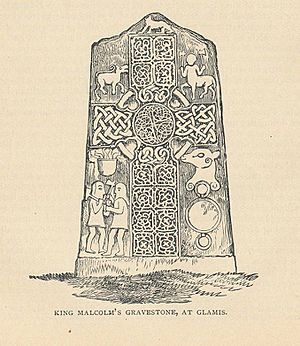Malcolm II of Scotland facts for kids
Quick facts for kids Malcolm II |
|
|---|---|
| King of Alba | |
| Reign | c. 25 March 1005 – 25 November 1034 |
| Predecessor | Kenneth III |
| Successor | Duncan I |
| Born | c. 954 |
| Died | 25 November 1034 (aged 79/80) Glamis, Scotland |
| Burial | Iona |
| Issue | Bethóc Donada Olith |
| House | Alpin |
| Father | Kenneth II of Scotland |
Máel Coluim mac Cináeda (Modern Scottish Gaelic: Maol Chaluim mac Choinnich), also known as Malcolm II, was a powerful king of Alba (which is now Scotland). He ruled from 1005 until he died in 1034. Malcolm was the son of King Kenneth II. Some old writings, like "The Prophecy of Berchán," called him Forranach, meaning "the Destroyer."
Back then, Scotland had several kings, not just one. Malcolm was the "High King" of Scotland, but there were also kings in places like Strathclyde and Moray. There were also Norse-Gael kings along the western coast and islands. To the south, in England, powerful earls controlled parts of what is now southern Scotland.
Contents
Becoming King
Malcolm II was born around 954. He was the grandson of Malcolm I of Scotland. In 1005, Malcolm II fought and defeated Kenneth III in a battle at Monzievaird. After this victory, Malcolm II became the new King of Alba.
An old writer named John of Fordun said that Malcolm defeated a Norwegian army soon after becoming king. He even claimed that the Bishopric of Mortlach was started to thank God for this win.
Malcolm's Family and Successors
Malcolm II was a very strong king, ruling for 29 years! This was a long time for kings back then. He didn't have any sons who lived to become king. So, he decided that his daughters would marry important men. This way, his family would still be in charge.
Malcolm's daughters married powerful leaders:
- His daughter Bethóc married Crinan, who was a very important religious leader and chief. Their son, Duncan I, later became king.
- His youngest daughter, Olith, married Sigurd, Earl of Orkney.
- His middle daughter, Donada, married Finlay, Earl of Moray. Finlay was the father of Macbeth, who also became a famous king.
By arranging these marriages, Malcolm made sure his family had strong connections across Scotland. This helped him keep peace and power.
Wars and Land
One of Malcolm's first big actions as king was invading Bernicia in 1006. This area is now part of northern England. However, the Scots were defeated by the Northumbrians at Durham.
Later, around 1018, Malcolm II fought another war in Bernicia. This time, he was more successful. The Battle of Carham, near the River Tweed, was a big victory for the Scots and their allies from Strathclyde. After this battle, it's believed that the Scots gained control of Lothian, a region between Dunbar and the Tweed River.
Meeting King Cnut
Around 1031, King Cnut of England led an army into Scotland. Cnut was a very powerful king who ruled England, Denmark, and Norway. The old records say that Malcolm II and Cnut made peace. Some historians think Malcolm might have gone on a religious journey to Rome around this time. This journey could have been where he met Cnut.
The meeting between Malcolm and Cnut was important. Malcolm promised peace and friendship, but he didn't promise to help Cnut in wars, which earlier English kings had demanded. The records say that Malcolm was joined by other kings, including Mac Bethad, who would later become king.
Control in the North
Malcolm's daughter Olith married Sigurd Hlodvisson, the Earl of Orkney. Their son, Thorfinn Sigurdsson, was very young when his father died. The "Orkneyinga Saga" says that Malcolm raised Thorfinn and gave him control of Caithness, a region in northern Scotland. This helped Malcolm extend his influence into the far north.
In the region of Moray, there were struggles for power. In 1020, Mac Bethad's father, Findláech, was killed. Later, in 1032, another leader in Moray, Gille Coemgáin, was killed. Some believe Mac Bethad was responsible, but Malcolm II also had reasons to want Gille Coemgáin gone, as his family could have been rivals for the Scottish throne.
Strathclyde and the Next King
For a long time, people thought that the kingdom of Strathclyde became part of Scotland after the Battle of Carham. However, there is evidence that kings of Strathclyde existed even after that battle. It seems Strathclyde was more of a separate kingdom that was loosely connected to Scotland, rather than fully controlled by it, during Malcolm's time.
Since Malcolm had no living sons, he chose his grandson Duncan I to be the next king. Duncan was the son of Malcolm's daughter Bethóc and Crínán of Dunkeld. Duncan was the first "tánaise ríg" in Scotland, which means he was the chosen heir to the throne.
Death and Legacy
Malcolm II died in 1034, on November 25th. Old writings describe him as a "most glorious" and "most victorious" king. The "Annals of Tigernach" called him "the honour of all the west of Europe." Some stories say he died fighting, but the exact details are not clear.
After Malcolm's death, his grandson Duncan I became king without any known opposition. This suggests that Malcolm had done a good job of securing the throne for his chosen heir.
There's a famous Pictish stone at Glamis called "King Malcolm's grave stone." While it's an ancient stone, its connection to Malcolm II is a long-standing tradition.
Malcolm II was known for his religious journeys. Many important people during his time, including King Cnut and later Mac Bethad, also traveled long distances for religious reasons. Malcolm also gave land and gifts to monasteries, like the one at Old Deer.
See also
 In Spanish: Malcolm II de Escocia para niños
In Spanish: Malcolm II de Escocia para niños


